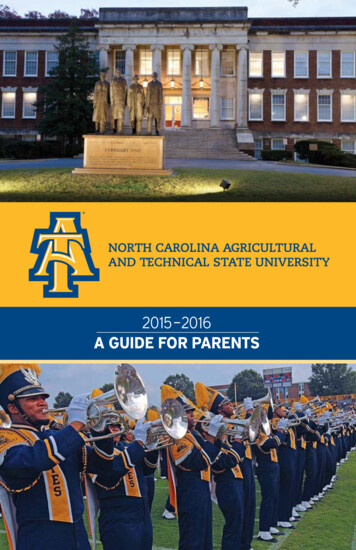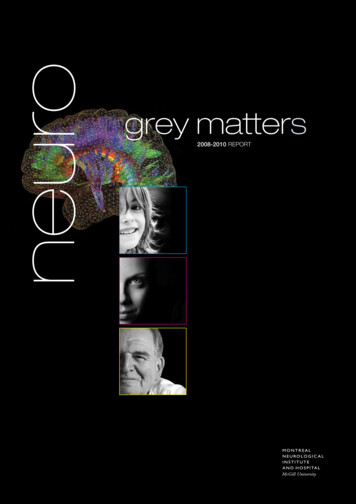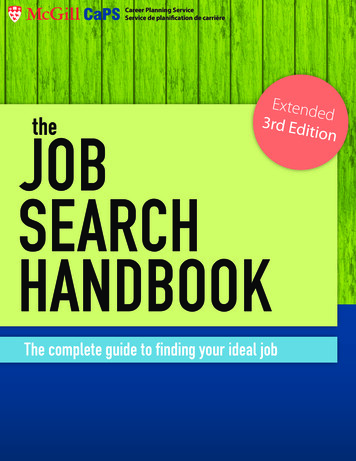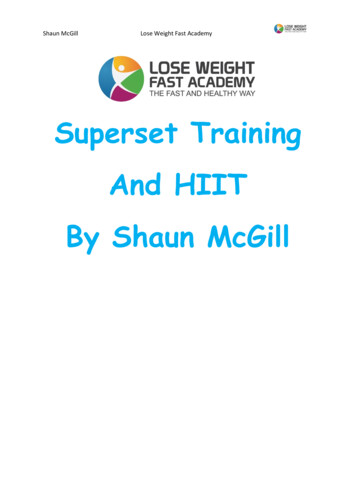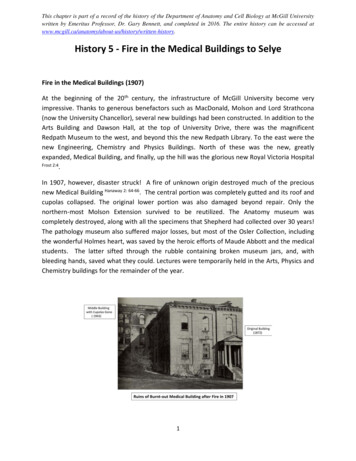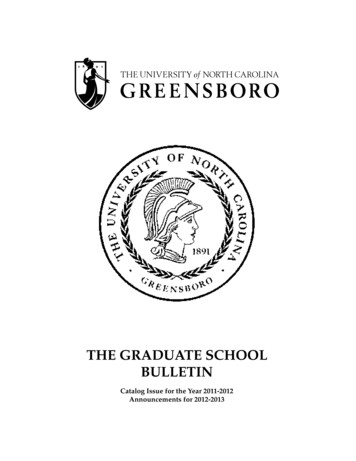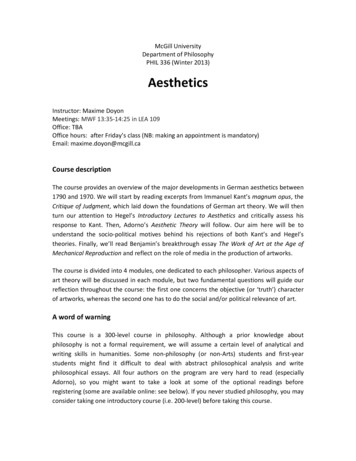
Transcription
McGill UniversityDepartment of PhilosophyPHIL 336 (Winter 2013)AestheticsInstructor: Maxime DoyonMeetings: MWF 13:35-14:25 in LEA 109Office: TBAOffice hours: after Friday’s class (NB: making an appointment is mandatory)Email: maxime.doyon@mcgill.caCourse descriptionThe course provides an overview of the major developments in German aesthetics between1790 and 1970. We will start by reading excerpts from Immanuel Kant’s magnum opus, theCritique of Judgment, which laid down the foundations of German art theory. We will thenturn our attention to Hegel’s Introductory Lectures to Aesthetics and critically assess hisresponse to Kant. Then, Adorno’s Aesthetic Theory will follow. Our aim here will be tounderstand the socio-political motives behind his rejections of both Kant’s and Hegel’stheories. Finally, we’ll read Benjamin’s breakthrough essay The Work of Art at the Age ofMechanical Reproduction and reflect on the role of media in the production of artworks.The course is divided into 4 modules, one dedicated to each philosopher. Various aspects ofart theory will be discussed in each module, but two fundamental questions will guide ourreflection throughout the course: the first one concerns the objective (or ‘truth’) characterof artworks, whereas the second one has to do the social and/or political relevance of art.A word of warningThis course is a 300-level course in philosophy. Although a prior knowledge aboutphilosophy is not a formal requirement, we will assume a certain level of analytical andwriting skills in humanities. Some non-philosophy (or non-Arts) students and first-yearstudents might find it difficult to deal with abstract philosophical analysis and writephilosophical essays. All four authors on the program are very hard to read (especiallyAdorno), so you might want to take a look at some of the optional readings beforeregistering (some are available online: see below). If you never studied philosophy, you mayconsider taking one introductory course (i.e. 200-level) before taking this course.
Course Outline and Readings1.Immanuel Kant (1724-1804)Can aesthetic judgments claim universal agreement? Is beauty objective or somethingpurely subjective? What is the difference between artistic and natural beauty? What is a(pure) judgment of beauty? What is the role of imagination in our artistic evaluations? Etc.Readings:The lecture will draw on the following sections from Immanuel Kant’s Critique of Judgement(translated by J.M. Meredith, Oxford: Oxford University Press 2008):- Preface, Introduction and First Introduction- Analytic of the Beautiful, §1 – 22.- Deduction of Pure Aesthetic Judgments, §30-54.Recommended Readings (optional):Burnham, Douglas: http://www.iep.utm.edu/kantaest/ (§1 and 2 only)Walker, Nicholas: “Introduction” to I. Kant, Critique of Judgement, transl. J.C. Meredith.2. G.W.F. Hegel (1770-1831)How can a science of art – an aesthetic – be possible at all? What is artistic beauty? What isthe aim (or purpose) of art? What is art’s relation to truth? Etc.Readings:G.W.F. Hegel, Introductory Lectures on Aesthetics, transl. Bosanquet, Penguin Classics,London: 1993, pp. 3-61.Recommended Readings (optional):Houlgate, Stephen: /Inwood, Michael, “Introduction”, to G.W.F. Hegel, Introductory Lectures on Aesthetics,transl. Bosanquet, Penguin Classics, London: 1993.3. Theodor W. Adorno (1903-1969)How can art contribute to the transformation of our world? In what sense can a work of artbe true? Reflections on the autonomy of the work of art, the socio-historical significance ofart, the disclosive character of art and the ‘truth-content’ of works of art.
Readings:Theodor W. Adorno, Aesthetic Theory, translated by R. Hullot-Kantor, Minneapolis:University of Minnesota Press, 1997, pp. 1-8, 118-136, 163-166, 225-261, 332-359.Recommended Readings (optional):Jarvis, S., Adorno. A Critical Introduction, Cambridge: Polity Press 1998. (ch.4)Zuidervaart, Lambert, http://plato.stanford.edu/entries/adorno/4. Walter Benjamin (1892-1940)What is artistic authenticity? How does the reproducibility of artworks alter the ‘aura’ ofartworks? Reflections on the changing political function of art in the age of technologicalreproduction.Readings:Benjamin, W., The Work of Art in the Age of its Mechanical Reproduction, translated by J.A.Underwood, Penguin: London 2008.Recommended Readings (optional):Benjamin, W., “The Work of Art in the Age of its Technical Reproducibility” (2nd VERSION), inThe Work of Art in the Age of its Technical Reproducibility and Other Writings, Jennings/Doherty/ Levin (Ed.), Harvard University Press, Cambridge 2008.Steiner, Uwe, Benjamin – An Introduction to His Work and Thought, University of ChicagoPress, Chicago 2010, pp. 115-126 (available as ebook via McGill’s library)Adorno, “Letter to Benjamin (London, 18 March 1936)”, in Jameson (Ed.): Aesthetics andPolitics, London: NLB 1977, pp. 120- 133.Where to find the textsRequired readings:I have ordered copies of the books we need for this course. All four titles are available at thebookstore The Word (469 Milton St.) for 78.50 (tax included; cash or cheque only).-Kant, Immanuel, Critique of Judgement, translated by J.M. Meredith, Oxford: OxfordUniversity Press 2008.
-Hegel, G.W.F., Introductory Lectures on Aesthetics, transl. Bosanquet, Penguin Classics,London: 1993.-Adorno, T.W., Aesthetic Theory, translated by R. Hullot-Kantor, Minneapolis: Universityof Minnesota Press, 1997.-Benjamin, W., The Work of Art in the Age of its Mechanical Reproduction, translated byJ.A. Underwood, Penguin Classics: London 2008.Please get your copies as soon as possible.Reserve:Except for the online sources, I have put all the required and optional readings at thereserve at McLennan on a 24-hour loan basis:Adorno, T.W., Aesthetic Theory, translated by R. Hullot-Kantor, Minneapolis: University ofMinnesota Press, 1997.Jarvis, S., Adorno – A Critical Introduction, Polity Press, UK 1998. (see especially ch.4)Hegel, G.W.F., Introductory Lectures on Aesthetics, transl. Bosanquet, Penguin Classics,London: 1993.Benjamin, W., The Work of Art in the Age of its Technical Reproducibility and Other Writings,Jennings/ Doherty/ Levin (Ed.), Harvard University Press, Cambridge 2008.Kant, Immanuel, Critique of Judgment, translated by J.M. Meredith, Oxford: OxfordUniversity Press 2008. (This book is also available as eBook via the Muse catalogue).Kant, Immanuel, Critique of Judgment, transl. by W. S. Pluhar, Hackett Publishing,Indianapolis 1987.Jameson (Ed.), Aesthetics and Politics, Verso, London 1980. (see p. 120-126).Steiner, Uwe, Benjamin – An Introduction to His Work and Thought, University of ChicagoPress, Chicago 2010. (cf. 115-126). (This book is also available as eBook via the Muse catalogue).Evaluation30%: Quiz. At the end of each of the first three modules, there will be a short in-class exam(or quiz) based on the readings and the material seen in class (10% each). Format: true andfalse, multiple choices, short answer, etc. The exact date of the exam will be announcedduring the prior lecture. Note that quizzes may not be made up without an appropriatemedical note, so stay in touch with a friend if you miss a class.
20%: Mid-term (take-home) Exam. There will be at least three essay questions on the midterm exam covering the readings and the material discussed in class so far. You will beasked to answer to one of these questions in a short 500-word essay. Date: To avoid conflictwith your other classes, the mid-term will take place after the usual mid-term exam period:the questions will be distributed on (Wed.) March 13th, and the exam can be submitted anytime thereafter until the end of the term (April 16th). However, if you wish to get somefeedback before you start writing your final paper (which I recommend highly, especially tonon-philosophy students), you should submit your paper before March 27th.50%: Final Essay. A 2500-word term paper based on the material covered by this course.Question/topics will be provided by the instructor around mid-March, and the essay is dueon Monday, April 22nd before noon.Please submit both a hard (LEA 929) and an electronic copy of the papers and exams youwish me to grade (maxime.doyon@mcgill.ca).***Policy on extensions: No extensions will be granted without an appropriate medical note.Late work will be penalized at the rate of a third of a grade per calendar day past the duedate. For example, a paper that is evaluated as a B, if one day late, will be assigned a gradeof B-; the same paper, if two days late, would receive a C .***All essays and exams are graded on your understanding of the material you have beenassigned to read, your understanding of the lectures, on your ability to express your ideasclearly. In accord with McGill University’s Charter of Students’ Rights, students in this coursehave the right to submit in English or in French any written work that is to be graded.***In the event of extraordinary circumstances beyond the University’s control, the contentand/or evaluation scheme in this course is subject to change.
Detailed Breakdown of the Lecture (tentative; subject to modification without prior notice)1. Immanuel Kant: Critique of Judgment1.1. Kant’s work in context1.2. The place of aesthetics in Kant’s critical philosophy1.3. Overview of Kant’s argument (read the Preface)1.4. The faculty of judgment (read the Introduction and the First Introduction)1.5. Aesthetic judgments (idem)1.6. Analytic of the Beautiful (read §1-22)- 1st Moment: Judgments of beauty are based on feelings of disinterested pleasure (§1-5)- 2nd Moment: Judgments of beauty lay claim to “universal validity” (§2-9)- 3rd Moment: The formal purposiveness of judgments of beauty (§10-17)- 4th Moment: Necessity and Exemplarity in aesthetic judgments (§18-22)1.7. Deduction of Pure Aesthetic Judgments (§9, 22, 35-39)1.8. Beautiful Art (§16, 43-48)1.9. Objections, Criticisms and Interpretative Issues2. G.W.F. Hegel: Introductory Lectures on Aesthetics2.1. Hegel’s work and the place of his aesthetics in the System2.2. Outline of his criticism of Kant’s aesthetics2.3. The range of aesthetics defined (Introductory Lectures , chapter 1)2.4. Scientific ways of treating beauty and art (Introductory Lectures , chapter 2)2.5. Three common ideas about art (Introductory Lectures , chapter 3)2.5.1. The work of art as a product of human activity2.5.2. The work of art as addressed to man’s sense2.5.3. The end (or aim) of art
2.6. The main differences between Kant’s and Hegel’s aesthetics (ch.4.1. – optional)2.6.1. Subjectivity and objectivity2.6.2. Beauty in nature, beauty in fine arts3. T.W. Adorno: Aesthetic Theory3.1. What is critical theory?3.2. The place of art in Adorno’s philosophy and in philosophy tout court3.3. What kind of aesthetics is needed? (Aesthetic Theory, 332-359)3.4. Adorno on Kant and Hegel (Aesthetic Theory, 163-166)3.5. The ‘truth content’ and ‘enigmatic character’ of artworks (Aesthetic Theory, 118-136)3.6. The autonomy of the work of art (Aesthetic Theory, 1-8)3.7. The social significance of art (Aesthetic Theory, 225-261)4. W. Benjamin: The Work of Art in the Age of its Mechanical Reproduction4.1. Authenticity and aura of artworks in the age of technical reproducibility (The Work ofArt in the Age of its Mechanical Reproduction, I-III)4.2. The secularizing potential implicit in the technical reproducibility of works of art (IV-V-VI)4.3. The transformation of the function of art in cinema (VII-VIII-IX)4.4. The political significance of art in the age of technology (X to XV, Epilogue)4.5. Adorno’s objections to Benjamin (if time allows only) (read Adorno’s letter in Jameson (Ed.))4.5.1. Production techniques and modes of production4.5.2. Artistic autonomy4.5.3. The truth content of mass culture** NB: The breakdown of the lecture outlined above is not binding in any way. The course of the lecturecan be modified by the instructor at any time.
Academic Honesty (required syllabus statement)McGill University values academic integrity. Therefore all students must understand themeaning and consequences of cheating, plagiarism and other academic offences under theCode of Student Conduct and Disciplinary Procedures (see http://www.mcgill.ca/integrityfor more information).Remember, any instance of presenting the work of someone else as your own counts asplagiarism, whether that someone else is your favourite philosopher, an anonymouswebsite author, or your mother. If you use an idea, an argument, or a phrase that is notyour own, be sure to cite it – even if it is from a website.
Detailed Breakdown of the Lecture (tentative; subject to modification without prior notice) 1. Immanuel Kant: Critique of Judgment 1.1.Kant's work in context 1.2.The place of aesthetics in Kant's critical philosophy 1.3.Overview of Kant's argument (read the Preface) 1.4.The faculty of judgment (read the Introduction and the First Introduction)
